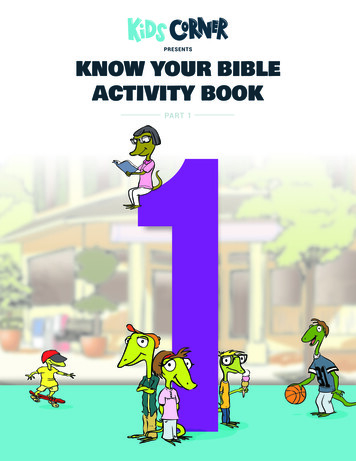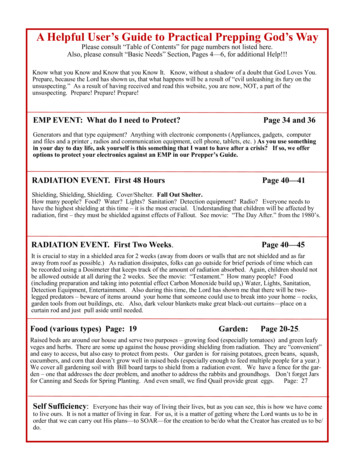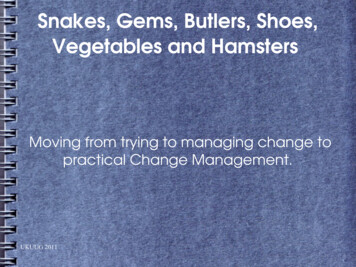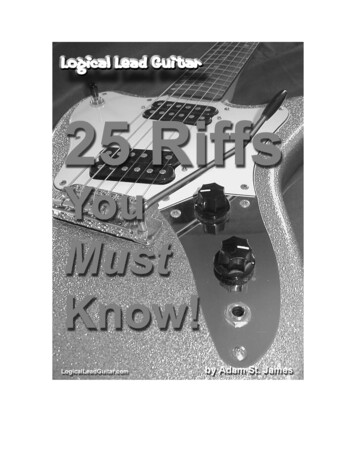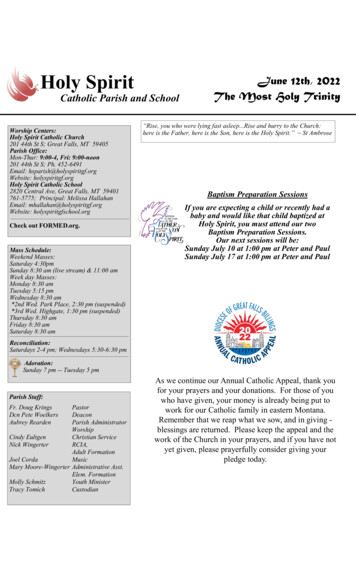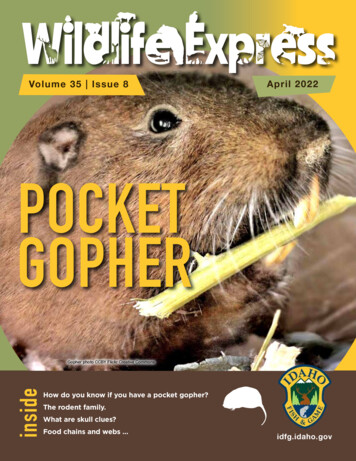
Transcription
Volume 35 Issue 8April 2022insideGopher photo CCBY Flickr Creative CommonsHow do you know if you have a pocket gopher?The rodent family.What are skull clues?Food chains and webs .idfg.idaho.gov
Three kinds of pocket gophers live in Idaho.They are the Townsend’s, northern and Idaho.Townsend’s pocket gophers are the largest.They are found in southwestern and southcentral Idaho. Northern pocket gophers arefound across most of Idaho. Idaho pocketgophers are the smallest and rarest. They arefound in eastern Idaho and have only been seenabout ten times over the last twenty years.Pocket gophers dig huge burrow systems. Astudy found that one pocket gopher mightexcavate as much as five tons of soil eachyear! With front paws the size of nickels,that’s pretty amazing. Their burrowsystems may be up to 500 feet long.If stretched out in a single line, thatwould be the length of one andone-half football fields!Burrow systems have an upstairsand downstairs. Upstairs is thegrocery store. Pocket gophers eatroots, tubers and other parts ofplants. They sometimes come tothe surface of the ground wherethey dart out and grab plants.They may also dig a tunnel about six to eightinches below the ground and pull plants intotheir tunnel. Pocket gophers’ lips close behindtheir front teeth, so they don’t have to worryabout getting a mouthful of dirt. To carryplants around their tunnels, they have fur-linedpouches on the sides of their faces. They shoveplants in the pockets and carry them downstairs.The downstairs part of the burrow is about sixfeet below the surface of the ground. Downstairscontains the pantry, sleeping chambers andnesting chambers.Photos CCBY Flickr Creative CommonsYou may have heard of pocket gophers,but have you seen one? Pocket gophers arefossorial (fa-SOHR-ee-uhl) animals. Fossorialmeans adapted to digging and burrowing.Pocket gophers spend more time undergroundthan they do above ground.
Unless a pocket gopher is actively using aburrow entrance, most are sealed closed. Pocketgophers push dirt out of the burrow and to oneside. When finished with the entrance, the holeis plugged with a dirt cap. Plugging the burrowhelps keep pocket gophers safe from birds ofprey, foxes, coyotes and other predators. Thedirt lines or ridges are formed during the winter.Pocket gophers are active all year; they don’thibernate. During the winter, they burrow intothe snow at the ground’s surface looking forfood. This winter burrowing causes ridges ofwinding dirt on the surface of the ground.Pocket gophers have bodies made for diggingand slipping through burrows. Their bodies aretube-shaped with short legs and short tails. Theyhave small eyes, and small ears partially coveredwith fur keep the dirt out. Long claws help themdig, and toes lined with stiff hairs help push dirt.Short, velvety fur allows them to move easilyforward and backward in cramped tunnels. Longfur would stick up when moving backward andslow down pocket gophers running from danger.Sometimes pocket gophers cause problemsfor people. They might destroy farmers’ fieldsor tear up a golf course. However, they also arebeneficial. Research shows their digging canhelp soils hold onto water and allows water toseep into underground aquifers. They loosensoils helping plants grow. There are also over20 different animals that use pocket gopherburrows for shelter or for raising a family.Look for pocket gophers while out exploringIdaho. If you are lucky enough to see one,you are sure to be entertained by their busyburrowing.Photos CCBY Flickr Creative CommonsLook for piles of dirt or winding, dirt lines.
A rodent is a mammal whose front teeth neverstop growing. Pocket gophers, squirrels, mice,and porcupines are all rodents. Most rodents eatplants, but some rodents are predators. Theymay eat insects or other small animals. There aremore rodents in the world than any other typeof mammal. Idaho has over 40 different kinds ofrodents.Idaho’s largest rodent is the beaver. The largestrodent in the world is the capybara (kap-ee-BARah). It is about the size of a pig. Capybara can weighmore than 125 pounds and be four feet long! Theyare naturally found in South America, but somehave been brought into the United States. One ofthe smallest rodents is the pygmy mouse of Africa.It weighs about as much as an unsharpened penciland is only two inches long.Because their front teeth never stopgrowing, rodents need to chew ontough things to keep their teeth fromgrowing too long. If they didn’t chew tokeep their teeth short, their teeth mayactually circle around and grow intotheir skulls!If you have a pet rodent like a mouse,hamster or guinea pig, you may havenoticed that your pet’s front teeth are ayellow-orange color. The teeth are onlyorange on the outside. Believe it or not,these teeth are supposed to be orange.The orange color is special enamel thathelps to make their teeth strong andhard. Imagine cutting down trees likebeavers. Wouldn’t you want strongteeth? The orange enamel also helpsto keep their teeth sharp. The hard,outside of the teeth wears down moreslowly than the softer inside. This keepstheir teeth chisel sharp.Some rodents may be seen as pests,but they are important parts ofecosystems. They are links in foodchains. Many animals depend onrodents for food. In some parts of theworld, even people eat rodents.Photo CCBY Idaho Fish and Game
You’re walking along a trail. All ofthe sudden, you see somethinggrayish-white peeking out ofthe grass. Leaning forward yourealize what it is – a skull. Nowthe mystery really begins. Whatanimal did that skull belong to,and how did this animal live itslife?This may be a hard question toanswer, but the skull will give yousome clues. One of the best cluesyou have are the teeth. Teeth tell youwhat an animal eats. Animals that eatmeat need teeth that will help them cutand tear. Meat eaters, called carnivores, havemeat cutting teeth along their cheeks. Theseteeth are sharp and pointed. When the topteeth and the bottom teeth come together, theteeth pass each other like scissors. A carnivore,like a mountain lion, has no problem slicingthrough an animal with its teeth!Sharp pointed teeth may work well for meateaters, but they sure wouldn’t help plant eaters.Plant eaters are called herbivores. Plants takea lot of chewing to break down. Just think howlong you need to chew celery! Herbivores havetall teeth with flat tops in the back of theirmouths. Flat teeth let the animals slide their topand bottom teeth against each other. Pocketgophers need teeth like these to grind up theroots and plants they like to eat.We have teeth in the back of our mouths withlow bumpy crowns, so do bears. Teeth withthis shape belong to omnivores. Omnivores eatboth meat and plants, so they need teeth thathelp cut and grind.The joint between the skull and jaw may alsohelp you tell if the animal ate meat or plants.Photo CCBY by Daniel Dvorsk, UnsplashMany rodents have a small ball on the end ofthe jaw that fits in a half circle on the skull. It issimilar to the joint of your hip or shoulder. Thisjoint allows herbivores to make circles to grindtheir food. Carnivores and omnivores tend tohave joints with straight lines.The location of the eye sockets on the skull canalso tell you a lot. Predators, animals that eatother animals, need to be able to tell distances.This comes in handy when reaching out tograb a mouse. Predators have eyes that faceforward. Prey animals, animals that are eaten byother animals, have their eyes located more tothe sides of their heads. This lets them look outfor danger in almost every direction, withoutever moving their heads.These clues may not tell you what animal theskull came from, but it is a start. You will havean idea of what the animal ate, and whether itwas a predator or prey animal.
Photos CCBY Flickr Creative Commons
Fawn Photo CCBY by Jax, Unsplash Daisy by Daiga Ellaby, UnsplashSpring is a time for renewal. It’s a time to getout of the house and explore all the wonders ofnature. Walks, bike rides and fishing trips maytake us closer to wildlife. You may see babyanimals. It’s a true sign that spring has arrived.When you hear people talking about enjoyinganimals, remember it is especially importantthat we leave animals alone. Let them do thethings they need to do to survive. Getting tooclose to wild animals might stress them andcause them to die.As humans, we have an urge to take care ofthings we think are helpless, especially “cute”animals, like young deer or rabbits. If yousee a baby animal, don’t assume it has beenabandoned by its mother. Most of the time, thisisn’t the case. Mothers often leave their younghidden while they go away to eat. If the motherstayed close to her baby, she could actuallydraw the attention of a predator. You may havescared the mother away. She will return once“danger” has passed.
Yay, spring is here! The days are slowly getting longer. You canleave your hat and mittens at home because it’s starting to getwarmer outside. Spring Break is right around the corner. Now is thetime to shake off the winter blahs and spend more time outside.Being outside is so much fun because you can see and do so manythings. The world is waking up from its long winter nap. Get outsideand see what is happening all around your neighborhood. Here aresome fun things to do this spring to enjoy the outdoors:Climb a tree Ride your bikeLook for early flowers like daffodils, tulips and dandelionsCheck your garden to see if plants are coming upHave a picnic on the first warm dayListen for the first bird songs of springWatch the clouds Check trees for swelling buds & new leavesPlay an outdoor game with your friends Go fishingTake a walk in the spring rainUse a stethoscope or small glass to listen for the sap rising incottonwood treesListen for frogs singing in a local pondStay outside after dark and look at the starsBuild a fort Read under a tree Play catchPhoto CCBY by James Wheeler, Unsplash
Photos CCBY Flickr Creative CommonsVolume 35 Issue 8Pocket Gopher April 2022Wildlife Express is published by the Idaho Departmentof Fish and GameEditor: Adare EvansLayout: Nancy JasperContributors: Adare Evans, Vicky RunnoeLead Writer: Adare EvansWE WOULD LIKE TO HEAR FROM YOU!If you have a letter, poem or question for Wildlife Express,it may be included in a future issue! Send it to:adare.evans@idfg.idaho.govorWildlife Express, Idaho Fish and GamePO Box 25, Boise, ID 83707
grab a mouse. Predators have eyes that face forward. Prey animals, animals that are eaten by other animals, have their eyes located more to the sides of their heads. This lets them look out for danger in almost every direction, without ever moving their heads. These clues may not tell you what animal the skull came from, but it is a start.
